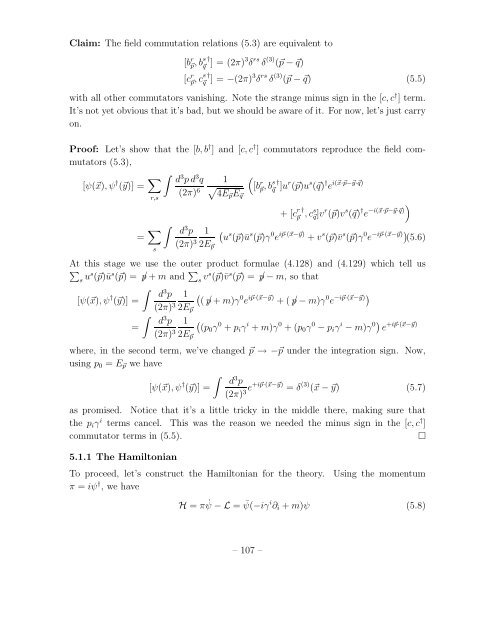Quantum Field Theory
Quantum Field Theory
Quantum Field Theory
You also want an ePaper? Increase the reach of your titles
YUMPU automatically turns print PDFs into web optimized ePapers that Google loves.
Claim: The field commutation relations (5.3) are equivalent to[b r ⃗p , bs †⃗q ] = (2π)3 δ rs δ (3) (⃗p − ⃗q)[c r ⃗p , cs †⃗q ] = −(2π)3 δ rs δ (3) (⃗p − ⃗q) (5.5)with all other commutators vanishing. Note the strange minus sign in the [c, c † ] term.It’s not yet obvious that it’s bad, but we should be aware of it. For now, let’s just carryon.Proof: Let’s show that the [b, b † ] and [c, c † ] commutators reproduce the field commutators(5.3),[ψ(⃗x), ψ † (⃗y)] = ∑ ∫ d 3 p d 3 q 1(√ [b r(2π)⃗p, b s †6 ⃗q 4E⃗p E ]ur (⃗p)u s (⃗q) † e i(⃗x·⃗p−⃗y·⃗q)r,s⃗q)+ [c r †⃗p , cs ⃗q ]vr (⃗p)v s (⃗q) † e −i(⃗x·⃗p−⃗y·⃗q)= ∑ ∫d 3 p 1 (u s (⃗p)ū s (⃗p)γ 0 e i⃗p·(⃗x−⃗y) + v s (⃗p)¯v s (⃗p)γ 0 e −i⃗p·(⃗x−⃗y)) (5.6)(2π) 3 2Es⃗pAt this stage we use the outer product formulae (4.128) and (4.129) which tell us∑s us (⃗p)ū s (⃗p) = /p + m and ∑ s vs (⃗p)¯v s (⃗p) = /p − m, so that∫[ψ(⃗x), ψ † (⃗y)] =∫=d 3 p 1 (( /p + m)γ 0 e i⃗p·(⃗x−⃗y) + ( /p − m)γ 0 e −i⃗p·(⃗x−⃗y))(2π) 3 2E ⃗pd 3 p 1 ((p0 γ 0 + p(2π) 3 i γ i + m)γ 0 + (p 0 γ 0 − p i γ i − m)γ 0) e +i⃗p·(⃗x−⃗y)2E ⃗pwhere, in the second term, we’ve changed ⃗p → −⃗p under the integration sign. Now,using p 0 = E ⃗p we have∫[ψ(⃗x), ψ † d 3 p(⃗y)] =3e+i⃗p·(⃗x−⃗y) = δ (3) (⃗x − ⃗y) (5.7)(2π)as promised. Notice that it’s a little tricky in the middle there, making sure thatthe p i γ i terms cancel. This was the reason we needed the minus sign in the [c, c † ]commutator terms in (5.5).□5.1.1 The HamiltonianTo proceed, let’s construct the Hamiltonian for the theory. Using the momentumπ = iψ † , we haveH = π ˙ψ − L = ¯ψ(−iγ i ∂ i + m)ψ (5.8)– 107 –
















